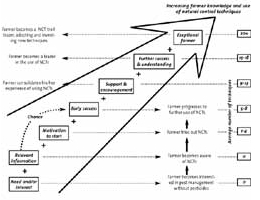Gabriele Stoll
Natural Crop Protection in the Tropics
Letting Information Come to Life
Letting information come to life
|
|
||
|
Learning and changing
|
|
|
|
|
 |
|
Letting information come to life
Learning and Changing:
Helping farmers move to natural pest
control
by Catrin J. Meir
Introduction
In late 1991, Zamorano, the Panamerican
School of Agriculture, based in Honduras, began offering a
three day training course in pest control without pesticides to
smallholder farmers from Central America. This course was the
brainchild of anthropologist Jeffery Bentley, who proposed that
scientists should try to fill the gaps in farmers' knowledge in
areas where farmers knew little, and learn from farmers in
those areas where farmers knew a lot. The Natural Pest Control
Course, as it came to be known, was developed by Bentley,
Gonzalo Rodríguez and Ana González, and helped
farmers to learn about insect biology and about natural
enemies. The objective of the training was to stimulate farmers
to adopt, adapt and invent natural control techniques and thus
to help farmers improve their standard of living through
increased productivity and reduced exposure to pesticides. The
course was highly participatory and innovatory in its approach
and was attended by farmers from all over Central America: by
1995 approximately 6 000 farmers had been trained.
The following discussion uses the
experience of the Natural Pest Control Course to examine how
training can bring information alive for farmers. It then
outlines what changes farmers can make with the new ideas if
this is achieved, and summarizes the impacts these changes can
have on farmers' productivity and pesticide use. The discussion
then looks at the process of change farmers go through as they
alter their pest management strategies to adopt natural control
techniques, and what makes some farmers adopt and others reject
these techniques. The discussion concludes by presenting
an outline of what can be done to encourage and support the
process of farmer adoption of natural control techniques.
Bringing information alive
Most people do not act on information
alone: the information must have some meaning for them.
Traditional approaches to teaching have mostly not valued what
pupils or trainees already know, or involved them in what will
be taught. Nor have such approaches taken into account that
sitting writing whilst someone else talks is not an effective
way to learn. In fact, it is frequently boring – think of
school! Such 'teaching' is most unlikely to motivate people to
use the information presented. If this is so for those of us
who are accustomed to working with the written word, imagine
how much more it must be true for farmers whose needs are
practical, who are used to sharing information by talking and
demonstration, and who are often intimidated and physically
uncomfortable in a classroom situation.
To be successful at initiating or
promoting change, farmer training must, therefore, be the
complete opposite of what most of us think of as 'school'. It
must value farmers and their knowledge, and build on this to
create an environment in which learning is maximized. It must
present information that interests farmers, in a form which
they can easily assimilate. It must actively involve the
farmers in the learning process, and use a variety of different
media to present ideas. And above all, it must be interesting,
exciting and motivating: information must fire the imagination
– it must come alive!
The following paragraphs examine how
these goals can be achieved in pest management training courses
for smallholder farmers, by looking at some aspects of the
technical content, the methodology (including the
trainer-farmer relationship) and the activities and materials
of training. (For a more complete analysis, see 638). These
aspects are illustrated by examples from the Natural Pest
Control Course, together with farmers' reactions to the course
as illustrations of its success at helping farmers learn and at
motivating them to use the new information.
Farmer adoption of Natural Control
Techniques (NCTs):
Steps in the process of change
The printed version contains more
information about the following themes:
Training methodology: The 'How' of farmer
training
The 'What' of farmer training: Technical
content
The 'Which' of farmer training: Activities
and materials
Changes farmers made with the new ideas:
Adoption, adaptation and invention of natural control
techniques
The impact of natural control: Better
productivity and reduced use of pesticides
The process of change: What makes farmers
adopt natural control techniques?
How can the process of change to natural
control techniques be supported?
